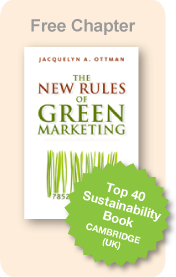Jacquie Ottman's
Green Marketing Blog
FTC Takes on Green Packaging Claims—And Not a Moment Too Soon
March 30, 2008 by Jacquelyn Ottman
As companies scurry to appeal to a fast-growing eco-consumer base, the Federal Trade Commission is stepping in to bring clarity to the arena of green marketing. As I write, numerous stakeholders are developing their testimony for an April 30 hearing on environmental claims for product packaging. Here’s a rundown of the key issues, and why they’re becoming more important by the day.
In January, the FTC held hearings with the goal of updating its Green Guides to include standards for the marketing of carbon offsets and renewable energy certificates. Now it’s time for packaging. Among others, terms such as “sustainable,” “renewable” “biodegradable” and “compostable” will be scrutinized.
What is “sustainable?” Those in the know, know that sustainable development relates to the triumvirate of “environment,” “economy,” and “society”? Can a package meet all three of these criteria? Not!
Expect lots of confusion over claims such as “renewable,” “biodegradable” “compostable” and “natural.” Packages made with a blend of traditional and natural or renewable ingredients, e.g., cornstarch, can’t always be counted on to compost either in backyard or even professionally managed municipal facilities.
Hopefully the updated Guides will bring some closure to use of the term “biodegradable” and start manufacturers and others educating consumers about the scientific principle of “biodegradability.” According to research fielded by the American Chemistry Council in 2006, over 80% of the people surveyed incorrectly believed that “biodegradable” products would break down or disappear into nothing in a year or less in a landfill or in the natural environment for example litter. In some respects, consumers believe that “biodegradability’ is the panacea to all our solid waste issues, despite the lack of any scientific data to support their beliefs
Two hundred and ninety-nine eco-logos have been counted globally and the number continues to escalate as trade associations, NGOs, governments, retailers and even the manufacturers themselves seek to help consumers identify products that contain greener ingredients (e.g. http://www.ams.usda.gov/nop/"USDA Organic), have been produced a certain way (e.g. http://www.green-e.org/"Green-e certified renewable energy) or represent reduced in-use impacts (e.g., Energy Star for energy efficiency), among other environmental benefits.
Sometimes, dueling logos fight for attention, e.g., Forest Stewardship Council (FSC)-certified sustainably harvested paper and wood produced by a consortium of environmental groups versus the American Paper and Trade Association’s Sustainable Forestry Initiative (SFI). Who’s to decide if there are too many logos? Which are most helpful to consumers? Which help consumers decide if one product is “greener” than another? Should more than one exist in a category?
Regarding self declarations, what incentives do retailers (like Home Depot’s Eco-Options logo) have not to emblazon the majority of their products with an eco-logo that has shown to help increase sales? What standards should exist to promote transparency?
The jury’s still out as to whether these efforts will result in new guides. Regardless of the outcome, manufacturers are urged to abide by the overall mantra of “reduce, reuse, recycle” (including composting) as they improve their products’ and packages’ environmental profiles and move forward to develop new ones.
Click here to join our mailing list.



 ShareThis
ShareThis

